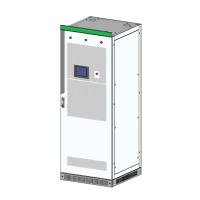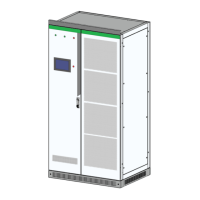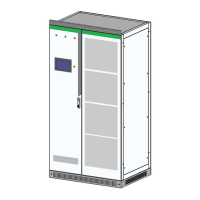Do you have a question about the Sinexcel PWS2-30M-EX and is the answer not in the manual?
Defines the model PWS2-30M-EX for the energy storage inverter.
Explains danger, warning, caution, and note icons used in the manual and on the inverter.
Provides essential safety guidelines for installation, operation, and maintenance of the inverter.
Outlines personnel requirements, usage purposes, label information, and general notes for safe operation.
Describes the components and configuration of the energy storage system including the inverter.
Details the physical dimensions of the PWS2-30M-EX inverter.
Illustrates and describes the front panel components and ports of the inverter.
Lists key technical specifications for the PWS2-30M-EX inverter, including DC and AC parameters.
Details the principle of operation, functions like FVRT and Volt/Watt, and protection mechanisms.
Specifies requirements for safely transporting and storing the inverter module.
Presents a flowchart outlining the step-by-step process for installing the energy storage system.
Lists checks to perform on the inverter case before installation to prevent transport damage.
Guides on checking the inverter's nameplate and preparing necessary tools for installation.
Covers environmental conditions and carrier requirements for proper inverter installation.
Provides detailed instructions and safety warnings for connecting DC and AC power cables, communication, EPO, and DRM0.
Outlines essential checks for cable connections and electrical/communication systems post-installation.
Details the procedures for safely starting up and shutting down the energy storage inverter system.
Explains how to interpret system, AC, and DC information displayed on the inverter's monitor screen.
Describes how to set parameters and obtain status information via Ethernet or RS485 communication.
Explains the supported RS-485 and Ethernet interfaces for monitoring and control.
Details how the inverter communicates with the Battery Management System (BMS) via RS-485.
Illustrates the network structure for background monitoring of multiple inverters.
Specifies the optimal temperature, humidity, and altitude for inverter operation.
Recommends routine inspections for grounding, electrical connections, and components.
Provides instructions for cleaning dust from terminals, mesh openings, and fans.
Lists system fault codes, their types, descriptions, and recommended advice for troubleshooting.
Outlines warranty terms, free maintenance, and conditions for not offering quality assurance.
| Model | PWS2-30M-EX |
|---|---|
| Category | Inverter |
| Rated Power | 30 kW |
| Output Frequency | 50/60 Hz |
| Maximum Efficiency | 98.6% |
| Number of MPP Trackers | 2 |
| Cooling Method | Forced Air Cooling |
| Operating Temperature Range | -25°C to +60°C |
| Protection Level | IP65 |
| Output Voltage | 400 V |
| Input Voltage Range | 200-1000VDC |




